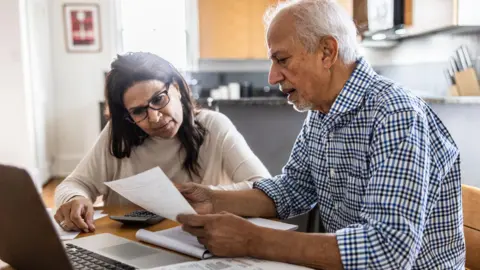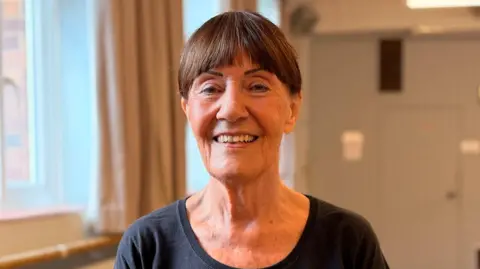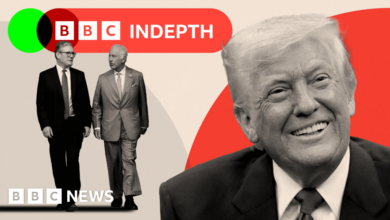State pension likely to rise by 4.7% next year

Pritti Mistrybusiness reporter and
Kevin Peacheycost of living correspondent
 Getty Images
Getty ImagesPeople drawing their new state pension from April are likely to see a rise of more than £500 a year, latest wages data suggests.
Under the “triple lock” policy, the state pension goes up each year by either 2.5%, inflation, or average earnings growth – whichever is the highest figure.
The Office for National Statistics (ONS) revealed total pay including bonuses for the three months to July was 4.7%, which is likely to be the figure used for the annual increase.
Almost 13 million people receive the state pension in the UK and current projections suggest pensioners will pay income tax on it from 2027 for the first time.
The latest wage figures from the ONS likely means:
- The new flat-rate state pension – for those who reached state pension age after April 2016 – is expected to increase to £241.05 a week. That will take it to £12,534.60 a year, a rise of £561.60 compared with now.
- The old basic state pension – for those who reached state pension age before April 2016 – is expected to go up to £184.75 a week. That will take it to £9,607 a year, a rise of £431.60 compared with now.
With inflation forecast to be 4% in September, it is likely Tuesday’s average earnings growth figure will be used to set the increase in the state pension for the third year in a row.
Sir Steve Webb, partner at pension consultants LCP and former pensions minister, said the standard rate of the new state pension was “creeping ever closer to the frozen personal tax allowance”, which currently stands at £12,570 and is set to remain at the same level until 2028.
The standard personal allowance is the amount of income permitted each year without paying income tax.
Sir Steve said that someone with no other income aside from the new state pension is set to be a taxpayer come April 2027.
“It is already the case that nearly three quarters of all pensioners pay income tax, and the ongoing freeze in tax thresholds coupled with steady rises in the pension will drag more and more into the tax net,” he added.
Linda, a retired hairdresser from Wokingham, told the BBC she was worried her state pension was being pushed towards the tax threshold.
“They’re giving it on one hand and it’s taken away in the other, so that’s not a load of good,” she said.
“If they could raise the tax threshold it would make a huge difference.”
The pensioner said she would struggle to manage on the state pension if she lived on her own.
“I’m lucky that my husband’s got a good pension so we have a fairly reasonable lifestyle but if left alone I don’t know what would happen to be honest.”

According to the ONS, regular wage growth – excluding bonuses – dropped to 4.8% in the three months to July, down from 5% in the previous three months and the lowest since May 2022.
Averages earnings growth in the public sector was 5.6% over the same period, while pay increases in the private sector were 4.7%.
Liz McKeown, the ONS director of economic statistics, said salary increases remained “strong by historic standards” despite it edging down further in cash terms.
However, Yael Selfin, chief economist at KPMG, said earnings growth was “likely to continue to decline over the coming year”.
“Demand for workers has fallen sharply due to a combination of weaker economic activity and businesses facing higher labour costs. As a result, we expect wage growth to fall below 4% by the end of the year,” she added.
Not all pensioners receive the full state pension because it depends on years of qualifying contributions through the National Insurance system.
For many retired people, the state pension is not their only source of income as they will also receive money from workplace or private pensions.
The state pension is the second-largest item in the government budget after health spending.
The Conservative-Liberal Democrat coalition designed the triple lock in 2011 to ensure the value of the state pension was not overtaken by the increase in the cost of living or the incomes of working people.
But there has been intense debate over the cost of the triple lock and whether it is justified, with Chancellor Rachel Reeves previously pledging that the Labour government would keep it in place until the end of the current parliament.
In July, the government’s official forecaster said the cost of the triple lock guarantee was set to be three times higher by the end of the decade than was originally anticipated when it began.
Work and Pensions Secretary Pat McFadden said the government promised to “honour” the triple lock for the “course of this parliament”.
“It is estimated that will mean a rise in the State Pension of around £1,900 a year by the end of the parliament,” he said.
The latest ONS data also revealed the UK unemployment rate hit at 4.7% in the three months to July, a level not seen since May 202. There was also a 10,000 drop in vacancies over the quarter to August, while the number of payrolled workers fell last month by 8,000.
Ms McKeown said the labour market was continuing “to cool” with firms telling the ONS there were “fewer jobs” available.
But the rate of decline “appears to be slowing”, she said.





